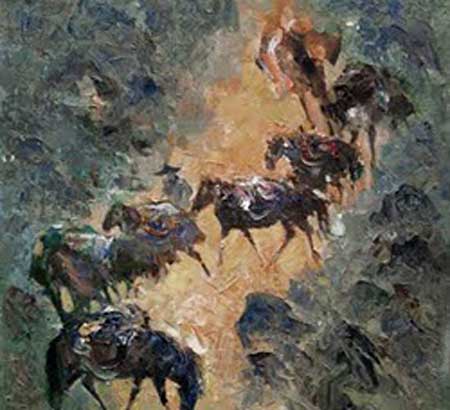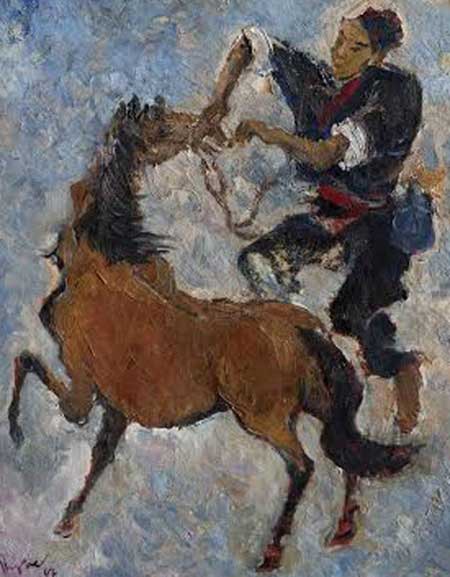Veteran painter Do Duc will again display his love for the rugged region of Ha Giang through his artworks, which are on display at his latest show opening on Friday.
Sacred beasts: Phieng Sa Slope, 2007 (right), and Selecting horse, 2007, are among the 50 oil paintings on display at artist Do Duc’s latest exhibition in Ha Noi.
This follows last year’s exhibition, Cao Nguyen Da (Living on Rock), however, unlike his previous art show which focused on the imposing landscape and unique ethnic culture of this northern mountainous region, all his paintings in this year’s exhibition are about horses.
“During my first trips to the northern mountainous area, I noticed the important role the horse played there. This animal is a part of the ethnic culture. The Mong people treat their horses with love and regard them as family members. The horse accompanies its owner to the market, carrying many heavy packs on its back. On the way home, when all the goods are sold, the owner still walks aside his horse, like a friend,” the painter said.
All 50 oil paintings on display at the Rock Mountain Horse exhibition were made during and after Duc’s numerous trips to the region beginning in 1982.
Very different from the large, shining race horses the public often sees, the horses in Duc’s paintings look calm and quiet.
“I have been watching horses from many perspectives and I choose the most simple way to depict them. I want the horse to be displayed naturally in its environment.
“In my paintings, visitors can find the worrisome horse, the sustaining horse, the young and full-of-energy horse, the lonely horse, horses in couples, horse by the market, or the patient horse who has been physically and emotionally sharing ups and downs with his human friend. In some paintings of the vast blue mountains, there is a little dot of life, and that’s the horse,” Duc added.
A young exhibition visitor, Duc Vu, said he was impressed by the unexpected result of the artist’s simple depictions. “The horse is the common object in every painting, yet there are tens of different feelings among these horses. It likes I can touch the feelings of the horses that are represented in these inspirational paintings.”
Sacred beasts: Phieng Sa Slope, 2007 (right), and Selecting horse, 2007, are among the 50 oil paintings on display at artist Do Duc’s latest exhibition in Ha Noi.
This follows last year’s exhibition, Cao Nguyen Da (Living on Rock), however, unlike his previous art show which focused on the imposing landscape and unique ethnic culture of this northern mountainous region, all his paintings in this year’s exhibition are about horses.
“During my first trips to the northern mountainous area, I noticed the important role the horse played there. This animal is a part of the ethnic culture. The Mong people treat their horses with love and regard them as family members. The horse accompanies its owner to the market, carrying many heavy packs on its back. On the way home, when all the goods are sold, the owner still walks aside his horse, like a friend,” the painter said.
All 50 oil paintings on display at the Rock Mountain Horse exhibition were made during and after Duc’s numerous trips to the region beginning in 1982.
Very different from the large, shining race horses the public often sees, the horses in Duc’s paintings look calm and quiet.
“I have been watching horses from many perspectives and I choose the most simple way to depict them. I want the horse to be displayed naturally in its environment.
“In my paintings, visitors can find the worrisome horse, the sustaining horse, the young and full-of-energy horse, the lonely horse, horses in couples, horse by the market, or the patient horse who has been physically and emotionally sharing ups and downs with his human friend. In some paintings of the vast blue mountains, there is a little dot of life, and that’s the horse,” Duc added.
A young exhibition visitor, Duc Vu, said he was impressed by the unexpected result of the artist’s simple depictions. “The horse is the common object in every painting, yet there are tens of different feelings among these horses. It likes I can touch the feelings of the horses that are represented in these inspirational paintings.”



